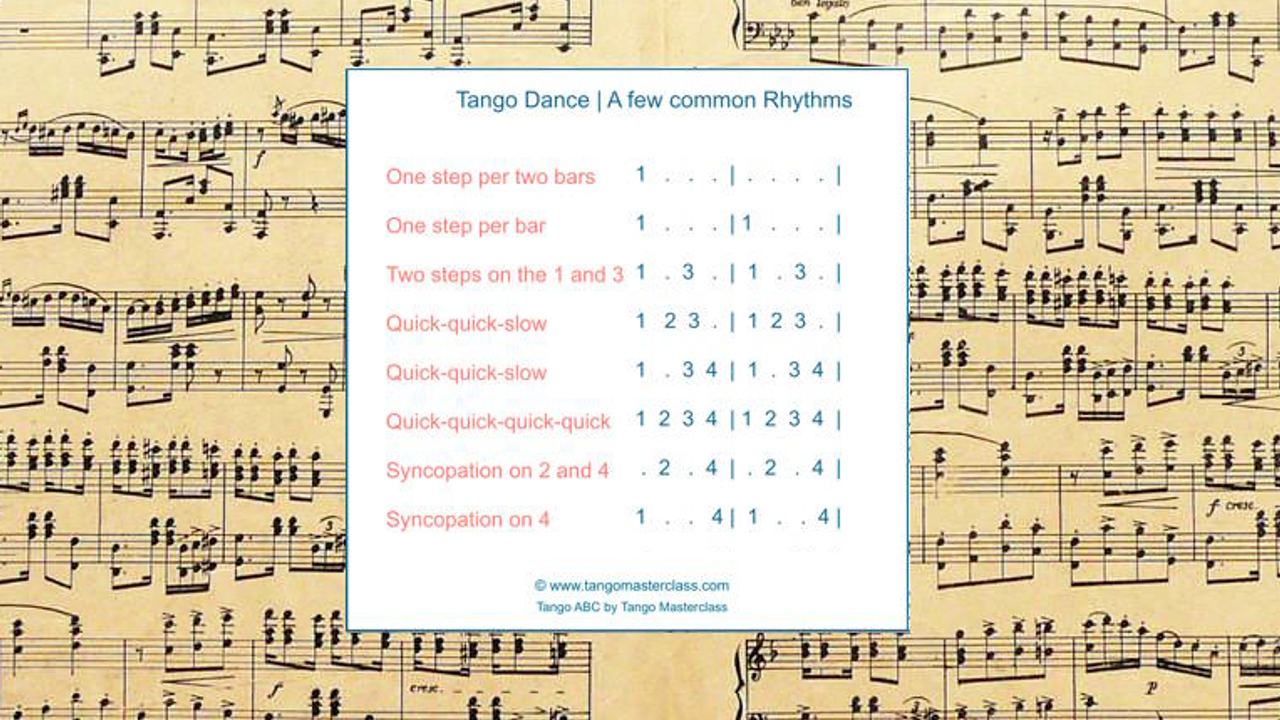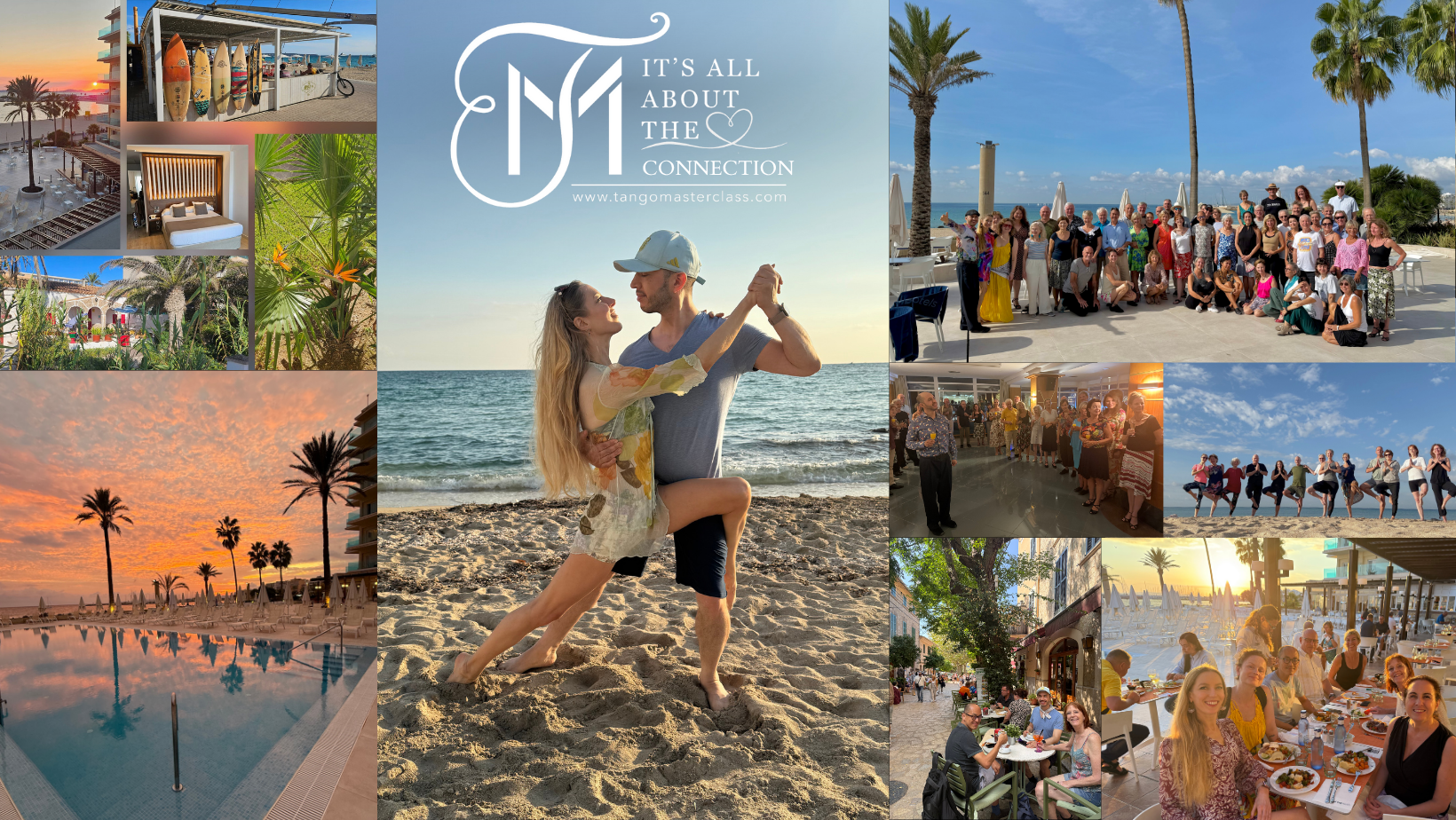Tango Rhythms for Dancers
Dec 03, 2021
Tango Dance | A few common Rhythms
© by Cosima Diaz Campos , 2 December 2021
The word rhythm is close to the ancient Greek word rhythmos, which is derived from the ancient Greek rhein, “to flow”. The ancient Greek concept of rhythmos probably refered to the momentary positions taken by dancers during the course of their performance.
Nowadays, in its most general sense, rhythm is an ordered alternation of contrasting elements. The philosopher Matila Ghyka synthesizes as follows:
“Rhythm is the experience of orderly flow of a movement”.
Rhythm in nature
the rhythm of our breathing and of our heart beating, our circadian rhythms, the circle of the earth around the sun (night and day), the circle of the moon around the earth (tidal ebb and flow), etc.
Rhythm in arts
music, dance, poetry, performance art, painting, drawing, sculpture, architecture, retorica, storytelling, etc.
Temporal & spatial
Rhythm, in music, is temporal: the pattern of sound, silence, and emphasis in a song.
Rhythm, in dance, is temporal and spatial: the pattern of movements in time and space.
Dance Rhythm: Movement, Music and Emotion
Rhythm, in dance, comes from three sources: movement, music and emotions. The emotion is a very important source for tango dancers. This means that we don't need to express every rhythmical variation of the music. The rhythm of the music is just one of the three sources of rhythm for dancers. We can be selective and also let the music shine, and feel the emotion of the music in ourselves, and in our partner, without the need to step or move at every accent.
Tango Rhythms
Tango is a four-four time. The beat that we dance to when teachers say 'a tiempo' (not 'contratiempo or doble tiempo) is on the 1 and 3 of the four-four time. The accents are place on these notes below:

In the image below you can see the most common rhythms in tango that we express in our dance with steps, turns, rotations, and movements with the free leg.

In this image, you can see a few common rhythms that we use in our tango dance. As dancers we are free to interpret the different rhythms played by the different instruments and voice. And even then, we are very selective and we don't step at every note, but we choose which musical rhytm to emphasize with a movement, or if we wish to express an emotion of the music with our movement.
We can dance to the rhythm of the music with our step, which is the most common. The moment of contact of the foot with the floor is the moment of an accent in the music. This can be on a regular strong beat (such as 1 or 3) or on both the strong beat and the half beats 1 and 3, or 3 and 1. Often orchestras play an accent on the 4, which we can also accentuate with a step.
Options to emphasize the rhythms with a step are:
- forward step / side step / backward step / diagonal step
- cross step front / cross step back
- changing weight on the spot: balance / balanceo
Other ways to interpret the rhythm as dancers instead of stepping are:
- collecting the feet on an accent, without a change of weight (lead!)
- our timing of the pivot (often between two strong beats, but it can also be used in accellarations to interprate the speed of the music with pivots)
- using the rebote with or without turn to empasize the rhythm
- the movement of the free leg in an adorno or style element
- the movement of the free leg in lead-follow movement, such as voleo, gancho, patada, etc.
Dancing emotion
To give you a wonderful example of the complexity and the brilliance of the tango rhythms, let's listen to the masterpiece Danzarín by Julián Plaza, played by Anibal Troilo and his orchestra. In the first video watch the musicians perform in Teatro Colón in 1964. In the second video you can also. you can listen to the studio recording.
For me personally, this brings back memories. When I played in the tango orchestra OTRA (violin) we played this piece. I loved to play this piece so much, it was my favourite. The piece starts with the violins, romantic and calm, and then that magical moment when the piano and bandoneons come in full force, with a glissando piano and then the whole orchestra picking up the beat, and then the violins in a mix of agony and joy, and then the strong syncopations... just listen to it and be mesmerized... goosebumps...
Of course, as dancers, we don't need to express the exteme complexity of these musical rhythms in our steps. As mentioned above, an important source for interpreting the dance-rhythm is emotion, and the emotions are very strong and tangible in this masterpiece.
Thank you for reading, and enjoy listening.
Abrazo,
Cosima
Danzarín
Composer: Julián Plaza
Orquesta Anibal Troilo


